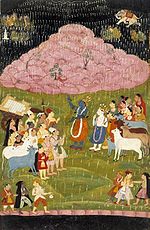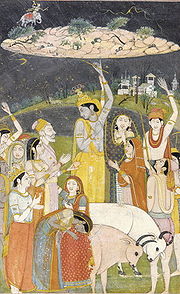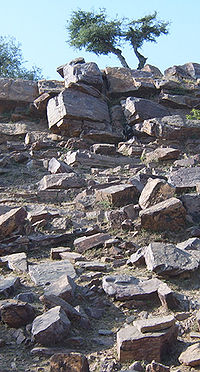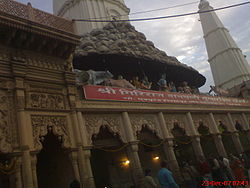
Govardhana sila
Encyclopedia

Buddhism
Buddhism is a religion and philosophy encompassing a variety of traditions, beliefs and practices, largely based on teachings attributed to Siddhartha Gautama, commonly known as the Buddha . The Buddha lived and taught in the northeastern Indian subcontinent some time between the 6th and 4th...
, Shiva
Shiva
Shiva is a major Hindu deity, and is the destroyer god or transformer among the Trimurti, the Hindu Trinity of the primary aspects of the divine. God Shiva is a yogi who has notice of everything that happens in the world and is the main aspect of life. Yet one with great power lives a life of a...
's Banalinga
Banalinga
Banalinga, a stone found in nature, in the bed of the Narmada river in Madhya Pradesh state, India, is an aniconic symbol of worship, based on either the scriptures or cultural traditions among the Hindus, particularly of the Shaivaites and Smartha Brahmins. Stones are ancient and connote divinity...
, Vishnu's Saligrama Sila (murthi)
Sila (murthi)
Shila, Shila, Shila, (शिला in Devanagari, in IAST refers to a Vaishnava (Hindu) aniconic representation of Vishnu, in the form of a spherical, usually black-coloured stone found in the sacred river Gandaki....
), etc . They have solar significance, and their use in worship predates the Hindu
Hindu
Hindu refers to an identity associated with the philosophical, religious and cultural systems that are indigenous to the Indian subcontinent. As used in the Constitution of India, the word "Hindu" is also attributed to all persons professing any Indian religion...
period in India
India
India , officially the Republic of India , is a country in South Asia. It is the seventh-largest country by geographical area, the second-most populous country with over 1.2 billion people, and the most populous democracy in the world...
. The Govardhana sila is a rock from the Govardhan hill
Govardhan hill
Govardhan is a hill located near the town of Vrindavan, in the Mathura district of Uttar Pradesh, India. It considered as sacred by a number of traditions within Hinduism....
in Vrindavana. Govardhan hill holds a unique position in Hindu Mythology related to Krishna
Krishna
Krishna is a central figure of Hinduism and is traditionally attributed the authorship of the Bhagavad Gita. He is the supreme Being and considered in some monotheistic traditions as an Avatar of Vishnu...
, the land called Vrij where He was born. The stone is usually brown in color. Known as Govardhan
Govardhan
Govardhan is a town and a nagar panchayat in Mathura district in the Indian state of Uttar Pradesh.-Geography:Govardhan is located at . It has an average elevation of 179 metres .-Demographics:...
or Giriraj and being the sacred center of Braj, it is identified as a natural form of Krishna.
Govardhan, a very famous place of Hindu pilgrimage, is located 26 km west of Mathura (154 km from New Delhi
New Delhi
New Delhi is the capital city of India. It serves as the centre of the Government of India and the Government of the National Capital Territory of Delhi. New Delhi is situated within the metropolis of Delhi. It is one of the nine districts of Delhi Union Territory. The total area of the city is...
) on the state highway to Deeg. Govardhan is located on a narrow sandstone hill known as Giriraj which is about 8 km in length.
When Chaitanya Mahaprabhu
Chaitanya Mahaprabhu
Chaitanya Mahaprabhu was a Vaishnava saint and social reformer in eastern India in the 16th century, believed by followers of Gaudiya Vaishnavism to be the full incarnation of Lord Krishna...
did parikrama (circumambulation) of Govardhana Hill while visiting Vrindavana in 1515 AD, he did not walk on the hill because he considered Govardhana as non-different from Lord Krishna. Therefore, traditionally Vaishnavas don’t step on Govardhan hill.
Legend

Indra
' or is the King of the demi-gods or Devas and Lord of Heaven or Svargaloka in Hindu mythology. He is also the God of War, Storms, and Rainfall.Indra is one of the chief deities in the Rigveda...
. This gave Krishna the epithet Govardhandhari. Since Lord Krishna declared that He and Govardhan Hill were non-different, the followers of the Gaudiya Vaishnava tradition, devotees of Lord Krishna, worship Govardhan Sila. They worship Govardhana-silas along with the Saligrama sila, both considered as aniconic symbols of the Supreme Personality of Godhead, exactly as they worship the Deity of Krishna in the temple.
English translation of the relevant texts on Govardahan Hill from Srimad Bhagvatam state:
Krishna assumed a great transcendental form and declared to the inhabitants of Vrindavana that He was Himself Govardhana Hill in order to convince the devotees that Govardhana Hill and KrishnaKrishnaKrishna is a central figure of Hinduism and is traditionally attributed the authorship of the Bhagavad Gita. He is the supreme Being and considered in some monotheistic traditions as an Avatar of Vishnu...
are identical. The identity of Krishna and Govardhana Hill is still honored, and great devotees take rocks from Govardhan HillGovardhan hillGovardhan is a hill located near the town of Vrindavan, in the Mathura district of Uttar Pradesh, India. It considered as sacred by a number of traditions within Hinduism....
, and worship them exactly as they worship the Deity of Krishna in the temple.” (Srimad Bhagavatam 10.24.35 purport)
Of all the devotees, this Govardhana Hill is the best! O my friends, this hill supplies Krishna and Balarama, along with Their calves, cows and cowherd friends, will all kinds of necessities—water for drinking, very soft grass, caves, fruits, flowers and vegetables. In this way the hill offers respects to the Lord. Being touched by the lotus feet of Krishna and Balarama, Govardhana Hill appears very jubilant.” (Srimad Bhagavatam 10.21.18).
Govardahan puja and hill parikrama


Govardhan hill
Govardhan is a hill located near the town of Vrindavan, in the Mathura district of Uttar Pradesh, India. It considered as sacred by a number of traditions within Hinduism....
is just 25m (80 feet) high and is a wide hill. It is a narrow sandstone hill known as Giriraj which is about 8 km in length.
After Krishna protected the inhabitants of Vraj (Vridavan) from the wrath of Indra
Indra
' or is the King of the demi-gods or Devas and Lord of Heaven or Svargaloka in Hindu mythology. He is also the God of War, Storms, and Rainfall.Indra is one of the chief deities in the Rigveda...
, he counseled them to worship Govardhana hill and they did by way of a Puja and a Parikrama (circumambulation) around the hill.Thus, a festival in commemoration of the lifting of Mount Govardhan, near Mathura, by Krishna came into vogue as Govardhan Puja when Mount Govardhan is worshipped day after Deepawali (fetival of lights) is celebrated. Pious people keep awake the whole night and cook fifty-six (or 108) different types of food for the bhog (the offering of food) to Krishna. This ceremony is called ankut or annakuta which means a mountain of food. Various types of food – cereals, pulses, fruit, vegetables, chutneys, pickles, and salads – are offered to the Deity and then distributed as prasada to devotees. Thousands of devotees bring offerings for Giriraj. Followed by this pooja, the devotees perform the Govardhana parikrama.
A Parikrama [circumambulation- going 38 km {24-miles} around the hill] is a sacred ritual called Govardana parikrama performed by many believers. There is no time limit for performing Govardhana parikrama, but for those who perform the dandavata (full prostration) Parikrama, an arduous form which may take weeks and sometimes even months to complete. It is performed by standing in one spot, offering obeisances like a stick (danda) by lying flat on the ground and then continuing, contiguously, till the entire route is covered. It is also said that some sadhus (Hindu holy men) perform 108 dandavata Parikrama by offering 108 obeisances in one spot before moving to the next. This can take a number of months to complete.
This ritual of circumambulation is considered to be even better if is it done with milk. A clay pot filled with milk, with a hole at the bottom, is carried by the devotees in one hand and a pot filled with dhoop (incense smoke) in another. An escort continuously fills up the pot with milk till the circumambulation is completed. Circumambulation is also done with candy being handed out to children, en-route.
Parikrama of Govardhana starts at the Manasi-Ganga Kund (lake) and then after having darsan of Lord Harideva, from Radha-kunda village, where the Vrindavan road meets the parikrama path. After parikrama of 38 km, covering important tanks, shilas and shrines such as Radha Kunda, Syama Kunda, Dan Ghati, Mukharavinda, Rinamochana Kunda, Kusuma Sarovara and Punchari, it ends at Mansi Ganga Kund only.
Shape of Govardhana hill
In Govinda-lilamrita, Krishnadasa Kaviraja Gosvami states that Govardhana Hill is shaped like a peacock and that Radha Kunda and Syama Kunda are its eyes. Dan Ghati and Manasi Ganga are its long neck. Mukharavinda is the mouth, Kusuma Sarovara its face, and Punchari is its back and tail feathers. A peacock often curves its neck and puts his head under its stomach. Govardhana Hill is thus shaped in this pose of a peacock.&Mala (garland) of Gunja seeds and Krishna
Followers of Chaitanya Mahaprabhu worship Krishna in a small stone form (Govardhana sila) representing Mount Govardhan, with a gunja mala (garland) around it representing Radharani. It is said that the child Krishna was inseparable from his favourite gunja maala which was said to represent Radha. This mythology has made the Gunjā (Abrus precatorius) seeds - the bright red seed of a fig tree - also a favourite for native jewellery.The only other God who shows a twig with a gunja seed on his upturned right hand palm to indicate the divya ksehtra’s superiority over Kashi (Varanasi) is Lord Narasimha, in the Gunja Narasimha Swamy temple locaterd at T.Narsipur in Mysore district in Karnataka
Karnataka
Karnataka , the land of the Kannadigas, is a state in South West India. It was created on 1 November 1956, with the passing of the States Reorganisation Act and this day is annually celebrated as Karnataka Rajyotsava...
on the bank of the Kaveri - Kapila - Spatika Sarovar sangam (confluence).

